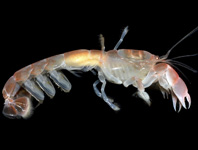Abstract
One hundred forty two specimens representing 56 species of longhorn beetles (Cerambycidae) from the Russian Far East were sequenced for a 658 bp fragment of the 5' end of the mitochondrial cytochrome oxidase subunit I gene (COI, =DNA barcode). The data are publicly available in an open access online library (dx.doi.org/10.5883/DS-CERRF). All analysed species could be differentiated using the standard online DNA barcode identification tool, except for a group of three sympatric colour-defined Menesia species. Seven Menesia records share the same Barcode Identification Number (=BIN), while the single specimen of M. flavotecta shares the same haplotype as some of M. sulphurata. Excluding the Menesia case, the Barcode Index Numbers (BINs) uniquely correspond to the analysed species, in all but the four specimens of Chlorophorus simillimus where they share two BINs. Although DNA barcoding aims to develop species identification systems, some phylogenetic signal was apparent in the data and in the Maximum Likelihood analysis, all four subfamilies were recovered as monophyletic. Notwithstanding the few detected deviations from the absolute taxonomic/phylogenetic match, DNA barcoding is a powerful identification tool with a capacity to place an undocumented record among its closest relatives.
References
Bucklin, A., Steinke, D. & Blanco-Bercial, L. (2011) DNA barcoding of marine Metazoa. Annual Review of Marine Science, 3, 471–508.
https://doi.org/10.1146/annurev-marine-120308-080950
Collins, R.A. & Cruickshank, R.H. (2013) The seven deadly sins of DNA barcoding. Molecular Ecology Resources, 13, 969–975.
https://doi.org/10.1111/1755-0998.1204
Cherepanov, A.I. (1996) 104. Cerambycidae – Usachi, ili Drovoseku. In: Ler, P.A. (Ed.), Opredelitel’ Nasekomykh Dal’nego Vostoka Rossii. Tome 3. Zhestkokrylye, ili Zhuki. Chast’ 3. Vladivostok, Dal’nauka, pp. 56–140. [in Russian]
Danilevsky, M.L. & Ivanov, S.N. (2014) “Tribe Monochamini: Anoplophora glabripennis (Motsch., 1853).” Available from: https://www.zin.ru/animalia/coleoptera/rus/anoglamd.htm (accessed 3 February 2017)
Felsenstein, J. (1985) Confidence limits on phylogenies: an approach using the bootstrap. Evolution, 39, 783–791.
https://doi.org/10.2307/2408678Grebennikov, V.V. & Heiss, E. (2014) DNA barcoding of flat bugs (Hemiptera: Aradidae) with phylogenetic implications. Arthropod Systematics & Phylogeny, 72, 213–219.
Hausmann, A., Haszprunar, G. & Hebert, P.D.N. (2011) DNA barcoding the geometrid fauna of Bavaria (Lepidoptera): successes, surprises, and questions. PLoS ONE, 6, e17134.
https://doi.org/10.1371/journal.pone.0017134
Hebert, P.D.N., Cywinska, A., Ball, S.L. & deWaard, J.R. (2003) Biological identification through DNA barcoding. Proceedings of the Royal Society of London B: Biological Sciences, 270, 313–321.
https://doi.org/10.1098/rspb.2002.2218
Hebert, P.D.N., Hollingsworth, P.M. & Hajibabaei, M. (2016) From writing to reading the encyclopedia of life. Philosophical Transactions of the Royal Society, B: Biological Sciences, 371, 20150321.
https://doi.org/10.1098/rstb.2015.0321
Hebert, P.D.N., Stoeckle, M.Y., Zemlak, T.S. & Francis, C.M. (2004) Identification of birds through DNA Barcodes. PLoS Biology, 2, e312.
https://doi.org/10.1371/journal.pbio.0020312
Hendrich, L., Morinière, J., Haszprunar, G., Hebert, P.D.N., Hausmann, A., Köhler, F. & Balke, M. (2015) A comprehensive DNA barcode database for Central European beetles with a focus on Germany: adding more than 3500 identified species to BOLD. Molecular Ecology Resources, 15, 795–818.
https://doi.org/10.1111/1755-0998.12354
Ivanova, N.V., deWaard, J.R. & Hebert, P.D.N. (2006) An inexpensive, automation-friendly protocol for recovering high-quality DNA. Molecular Ecology Notes, 6, 998–1002.
https://doi.org/10.1111/j.1471-8286.2006.01428.x
Lung, O., Nadin-Davis, S., Fisher, M., Erickson, A., Knowles, M.K., Furukawa-Stoffer, T. & Ambagala, A. (2013) Microarray for identification of the chiropteran host species of rabies virus in Canada. Microarrays, 2, 153–169.
https://doi.org/10.3390/microarrays2020153
Mallo, D. & Posada, D. (2016) Multilocus inference of species trees and DNA barcoding. Philosophical Transactions of the Royal Society, B; Biological Sciences, 371, 20150335.
https://doi.org/10.1098/rstb.2015.0335
Miller, M., Pfeiffer, W. & Schwartz, T. (2010) Creating the CIPRES Science Gateway for inference of large phylogenetic trees. Proceedings of the Gateway Computing Environments Workshop (GCE), New Orleans, LA, 2010, pp. 1–8.
https://doi.org/10.1109/GCE.2010.5676129Nadin-Davis, S.A., Guerrero, E., Knowles, M.K. & Feng, Y. (2012) DNA barcoding facilitates bat species identification for improved surveillance of bat-associated rabies across Canada. The Open Zoology Journal, 5 (Supplement 1-M5), 27–37.
https://doi.org/10.2174/1874336601205010027Oba, Y., Ôhira, H., Murase, Y., Moriyama, A. & Kumazawa, Y. (2015) DNA barcoding of Japanese click beetles (Coleoptera, Elateridae). PLoS ONE, 10 (1), e0116612.
https://doi.org/10.1371/journal.pone.0116612
Pentinsaari, M., Hebert, P.D.N. & Mutanen, M. (2014) Barcoding beetles: a regional survey of 1872 species reveals high identification success and unusually deep interspecific divergences. PLoS ONE, 9 (9), e108651.
https://doi.org/10.1371/journal.pone.0108651
Rambaut, A. (2014) FigTree, Version 1.4. Available from: http://tree.bio.ed.ac.uk/software/figtree/ (accessed 12 March 2014)
Raupach, M.J., Hannig, K., Morinière, J. & Hendrich, L. (2016) A DNA barcode library for ground beetles (Insecta, Coleoptera, Carabidae) of Germany: The genus Bembidion Latreille, 1802 and allied taxa. ZooKeys, 592, 121–141.
https://doi.org/10.3897/zookeys.592.8316
Ratnasingham, S. & Hebert, P.D.N. (2007) BOLD: The Barcode of Life Data System (www.barcodinglife.org). Molecular Ecology Notes, 7, 355–364.
https://doi.org/10.1111/j.1471-8286.2007.01678.x
Ratnasingham, S. & Hebert, P.D.N. (2013) A DNA-based registry for all animal species: the barcode index number (BIN) system. PLoS ONE, 8, e66213.
https://doi.org/10.1371/journal.pone.0066213
Shorthouse, D.P. (2010) SimpleMappr, an online tool to produce publication-quality point maps. Available from: http://www.simplemappr.net (accessed 12 February 2017)
Stamatakis, A. (2006) RAxML-VI-HPC: maximum likelihood-based phylogenetic analyses with thousands of taxa and mixed models. Bioinformatics, 22, 2688–2690.
https://doi.org/10.1093/bioinformatics/btl446
Ward, R.D., Hanner, R.H. & Hebert, P.D.N. (2009) The campaign to DNA barcode all fishes, FISH-BOL. Journal of Fish Biology, 74, 329–356.
https://doi.org/10.1111/j.1095-8649.2008.02080.x
Wilson, J.J., Rougerie, R., Schonfeld, J., Janzen, D.H., Hallwachs, W., Hajibabaei, M. Kitching, I.J., Haxaire, J. & Hebert, P.D.N. (2011) When species matches are unavailable are DNA barcodes correctly assigned to higher taxa? An assessment using sphingid moths. BMC Ecology, 11, 18.
https://doi.org/10.1186/1472-6785-11-18Wong, E.H.-K. & Hanner, R.H. (2008) DNA barcoding detects market substitution in North American seafood. Food Research International, 41, 828–837.
https://doi.org/10.1016/j.foodres.2008.07.005Wu, Y., Trepanowski, N.F., Molongoski, J.J., Reagel, P.F., Lingafelter, S.W., Nadel, H., Myers, S.W. & Ray, A.M. (2017) Identification of wood-boring beetles (Cerambycidae and Buprestidae) intercepted in trade-associated solid wood packaging material using DNA barcoding and morphology. Scientific Reports, 7, 40316.
https://doi.org/10.1038/srep40316Yang, R., Wu, X., Yan, P. & Li, X. (2010) Using DNA barcodes to identify a bird involved in a birdstrike at a Chinese airport. Molecular Biology Reports, 37, 3517–3523.
https://doi.org/10.1007/s11033-009-9945-0

